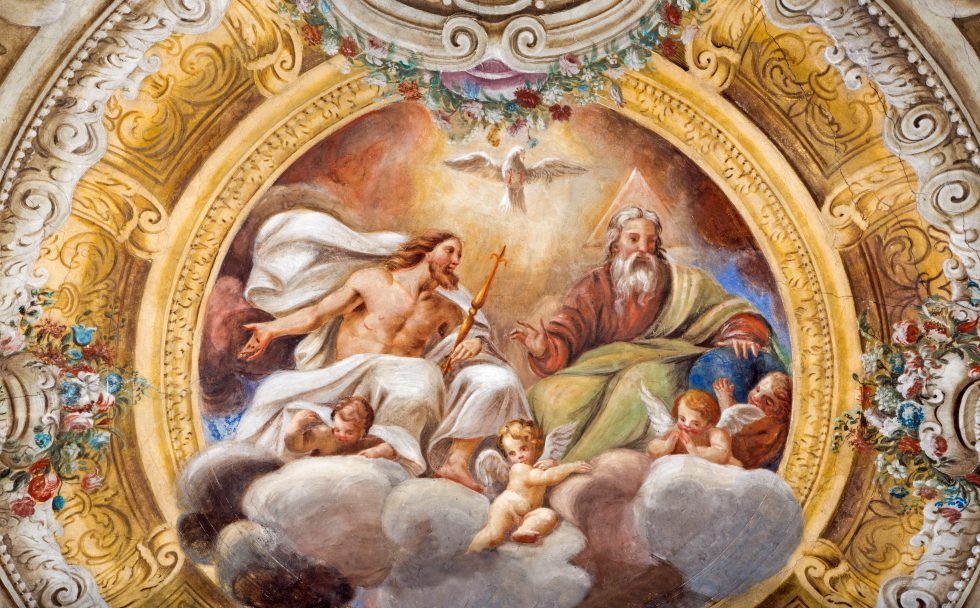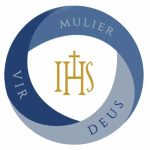In the Catechism of the Catholic Church we are taught that the central mystery of the faith, the fundamental and essential teaching of Christianity, is the doctrine of the Trinity (234). This is the revelation that our Almighty Creator is one God in three Persons: the Father, the Son, and the Holy Spirit. This is a mystery inaccessible to our finite human reason alone, but God has lovingly unveiled this truth about his inner life to us. How do we understand this teaching that God is one yet three? This is beyond our full comprehension, but we should not let this be an obstacle to meditating on this mystery.
One Divine Nature and Three Divine Persons
As Catholics, we reject any ideas of polytheism so we cannot misunderstand the Triune God to be teaching there are three Gods. We hold there is one true God who alone we worship. This Supreme Being has one divine nature and this nature is fully possessed by three Divine Persons. But what does this mean?
Before discussing the doctrine, I find it helpful to first understand what Catholic philosophy means with the terms “being,” “person,” and “nature.” In brief, we can refer to anything that exists as a “being.” Among these beings, some are living and some are nonliving. Among the living beings, some are nonrational while others are rational (and “rational” refers to those beings that have an intellect and a free will). We refer to any being who is rational as a “person.”
A “nature” tells us what actions and attributes are possible for a being. We can look at a living being like a dog: it has a dog nature so it is natural for a dog to walk on four extremities, to bark and to run. The dog does not deliberate on the actions it could take but acts on instinct. For us, we are human beings with a human nature. It is a characteristic of our human nature that we have a physical body, a soul; we walk, talk, and laugh. We are also rational beings so we think and make free choices about how we act.
When we speak of a “person” in relation to a “nature,” I like the analogy of seeing the person as the operator and the nature as telling us what operations are possible. For example, as a human person, our human nature tells us what operations are possible. We cannot fly as that is natural to birds, not humans. Unlike dogs, by our nature, we have the ability to reflect on why we experience suffering. And with our human nature, we have an intellect but our human mind is finite (limited) so, unlike God, we cannot know all things.
When we consider the “nature” of humans and other earthly creatures, such as dogs, our lived experiences help us to imagine the possibilities and limitations. But when we study what God has revealed about his nature, it should not surprise us that there is much we cannot fathom and there are truths about God beyond our reason and experiences. But, if we keep in mind the distinction between the terms “person” and “nature,” it can be beneficial as we reflect on the doctrine of the Trinity.
Truths Known About God
The word “Trinity” is a combination of “tri” and “unity” and is used in theology because we know through revelation that God is one yet three. God has one divine nature and there are three divine persons in the one Godhead: the Father, the Son and the Holy Spirit. These three persons are in communion with each other such that they are truly distinct persons, yet they are also inseparable and indivisible.
We know some of the attributes of the divine nature through revelation. These qualities include being pure spirit (no material parts), having the divine intellect, having the divine will, being all-powerful (omnipotent), all-knowing (omniscient), eternal, unchanging and being outside of time with no beginning and no end. Other divine attributes include being infinite, being everywhere (omnipresent), being Love itself, being Truth itself and being perfect in goodness, justice and mercy.
Each of the divine persons fully possesses the divine nature and these attributes. Because of this, each person is rightly described as being fully God. There is nothing one divine person has that the others lack. What distinguishes them is their relationship with each other. The Father is not the Son and the Son is not the Holy Spirit. God the Holy Spirit is eternal, unchanging, all-powerful, all-knowing and perfect. And we say the same about God the Father and God the Son. We do not hold that God the Father is more powerful than the other Divine Persons. We do not hold that God the Father existed before God the Son. All three divine persons have no beginning and no end, all created the world, all spoke through the prophets, and all love unconditionally.
Principle of Appropriation
At times in Scripture and in Church teaching we may see that certain actions are assigned to one of the Divine Persons. As an example, God the Father is often referred to as the Creator, God the Son is called Wisdom, and the Holy Spirit is called Love. This is called the principle of appropriation. This is not intended to suggest exclusivity in these actions but rather it is something done for our sake — for catechetical purposes to emphasize that in God there are three persons who are distinct. But all three Divine Persons can be called “Creator,” “Wisdom” and “Love.” The only action of God that is truly unique is that it is only God the Son who became man.
Errors About God
It is very challenging and often overwhelming to try to contemplate what has been revealed about God. (If you feel this way, you are not alone!) In my own studies, I have found it beneficial to look at the heresies that have arisen over the centuries related to the mystery of the Trinity because, in knowing what the Church condemns as false, we can avoid the same errors in our own thinking.
Here are a few heresies whose beliefs were rejected in the early Church:
Gnosticism (existed during the first few centuries of Christianity): This was a religious movement whose beliefs varied widely among the different sects but there were some common errors. For one, they held that all matter is evil while spiritual things are good. They believed the human soul is in bondage and the goal of life was for the spirit to escape the material prison of the body. They also taught that the God of the Old Testament was evil since he is shown creating matter and there was a different God of the New Testament who is the God of Love. One sect of Gnosticism was a group called the Docetists who held that Jesus Christ only appeared to take on human flesh because the good God would never have been associated with matter.
Adoptionism (around AD 200): This group held there was one God who was one divine person. They also believed Jesus Christ was not God. They taught he was merely a human person and, at Jesus’ baptism by John in the Jordan River, God adopted him and gave him extraordinary powers. (Biblical Unitarians today have a similar view.)
Modalism (also called Sabellianism, around AD 200): They held that there was one God and only one divine person. This one person manifested himself to the world in three different modes. God could be seen as the Father in creation, as the Son in redemption, and as the Holy Spirit in sanctification. But there are not three persons; there is only one. If we use the analogy of a woman who is a wife, a mother and a teacher to help us understand God, this is Modalism: God is one person but he puts on different masks as he accomplishes different tasks in the world. (One-ness Pentecostals such as the United Pentecostal Church today have a similar view.)
Arianism (AD 300): According to them, there was one God (the Father) who is eternal. Jesus was created by God and, as the firstborn of all creatures, he is unique. However, Jesus was not equal to God the Father in this heresy. (The Jehovah Witness group today are not Arians but they hold some similar views.)
The Macedonians and the Pneumato–machians (AD 200-400): These were two different groups in the early Church but both denied the divinity of the Holy Spirit.
Even though we may still see some of these ideas influencing various groups even today, all of the above teachings were rejected by the Church as being false views about what God has revealed about himself.
Imperfect Analogies
As we continue to try to understand more about God, sometimes we use things familiar to us as analogies. These analogies may be helpful to make certain comparisons but, if we use them, it is important to recognize these all fall far short of being accurate explanations for God. We can still use them in teaching at times, but these do become erroneous if we fail to recognize their limitations.
I mentioned the analogy of a woman who had three different roles earlier: she is a wife, mother and teacher. This analogy can be used to show how one can also be three. But it is not an accurate explanation of the Triune God because it portrays Modalism. Another common analogy is using the idea of H2O: these molecules form one substance, water. And water can have different forms: solid, liquid or gas. While this again portrays the idea of how one substance can also be three and is useful for that purpose, it is also expressing Modalism (one God with three modes of acting in the world), so it falls short in depicting God.
Another common analogy used for God is the shamrock: one flower with three leaves. This may be helpful to demonstrate how it is not necessarily a contradiction to say that three things can also be one. However, this analogy falls far short when used as a description of the Trinity. If I examine only one of the pedals, is this pedal fully the shamrock? No, isolated from the flower it is not a shamrock. Yet with God, if I describe the Holy Spirit, he is fully God. He lacks nothing that the others possess except the relationships with the other persons. Plus, unlike a flower pedal, three divine persons are inseparable from each other.
I have also seen the analogy of musical chords. You take the chords C, E and D: each is a distinct note but when you hit them all at the same time you have one chord whose sound is far richer than each note alone. The image of this one chord composed of three notes is useful to show not only how one can be three, but it also depicts the idea of three being inseparable. However, this analogy is far from perfect. The C note on its own is not fully the whole chord. The E note lacks the sound the D note has. So again, an imperfect analogy for the Triune God.
Contemplating the Trinity: It’s About Love
The doctrine of the Trinity is difficult and beyond our full comprehension, but it is a beautiful and intimate truth about the infinite God. It is important for us to meditate on this mystery because, just as in our human friendships, the more we come to know others the more we can love them. These truths should inspire us to never stop studying and growing in our understanding of all God has revealed. As the Catholic author Frank Sheed wrote in his book Theology and Sanity, “Love of God is immeasurably more important than knowledge of God; but if a man loves God knowing a little about Him, he should love God more for knowing more about him: for every new thing known about God is a new reason for loving him” (p. 29).
And God has revealed that the reason he created us is because he desires a relationship with us now and for all eternity. Everything he does is because of his love for us. Unveiling the mystery of the Trinity is a loving invitation for us to contemplate him and, as we do, he will draw us into closer communion with himself — the Father, the Son and the Holy Spirit.
For further reading, read the Catechism of the Catholic Church, 234, 237, 253-256.





